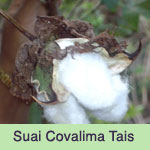 Suai-Covalima’s Tais was written by
Suai-Covalima’s Tais was written by
Ajay, Densi & Ameu who were made up one of the collaborative groups in the YoMaTre Digital Stories workshop held in Suai in June 20008. (Densi and the women in her family are weavers from Kamenassa near Suai.)
Tetun Version: Tais Suai Covalima
The Suai-Covalima’s tais are very beautiful since they have a variety of types and colours. The Suai-Covalima’s tais look most beautiful when they are worn during the ceremonies especially by women for dancing.
“The models of tais Covalima”, “Cotton tree”, “Cotton wool”, Cristalina Moniz, Residential Address: Fatuk Laran. Occupation: spinning traditional cotton wool”.
The process of turning cotton wool into threads takes a long time. Because of that only very few people who still make tais from the traditional—locally grown—cotton, while many women make tais from imported modern threads, that is, threads from Indonesia.
Traditional Threads
The making of traditional threads required the following materials:
A special shape of wood—beautifully crafted from solid wood for spinning.
A small bowel—traditionally either made form wood or mud for spinning.
Process of making traditional threads
1. It takes at least one month to spin the cotton
2. Boiling and drying cotton take one week
3. Rolling the cotton takes four days
4. Making design on the thread (turning into futus) takes two months
Modern thread
The process of making tais from modern threads is faster. Therefore more women prefer to make tais from modern threads. It is faster to roll, to dye and design.
“Modern threads (threads made in Indonesia)”, “Tais designed with flowers”, “Tais designed with names.”
Process of making tais from modern threads:
1. Rolling the threads
2. Dyeing the threads
3. Designing the threads (turning it into futus)
4. Colouring the threads by way of boiling them with colourful modern liquids).
Tais Designs
Tais can be designed with flowers, with names of people or places. There are diverse designs.
“welcoming the visit from the government”, “sitting together”, “preparation to welcome guests.”
The Role of the Tais in Timorese life
1. For wearing during the traditional ceremonies
2. For covering the dead bodies (the dead bodies are covered with layers and layers of tais, the quality and quantity of tais depend on the social status of the dead person)
3. For gift exchanges
4. For bride prize
5. For welcoming the visit of the government or the head of the Church, and for welcoming the statue of the Blessed Mother Mary (usually during the procession months for the Blessed Mother Mary, May and October.
SUMMARY:
The traditional threads still exist, but nowadays not so many women use traditional threads for making tais. More and more women use modern threads. This is simply because modern threads do not need a long process for making tais.










